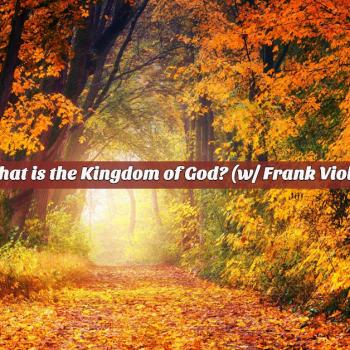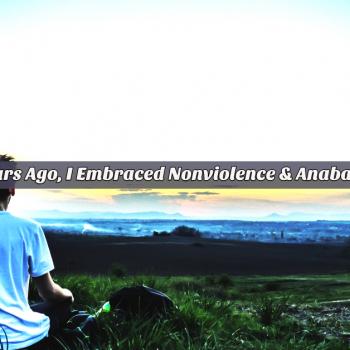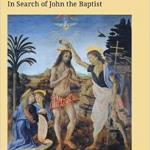This series wrestles with the questions of the compatibility of Biblical theology and biological evolution. To understand my view of Genesis 1, you may read here as that chapter will not be discussed in this series. Also, check out this series by RJS at Jesus Creed. The rest of this series, go here (in the first post, I present an option of Adam being historical).
—————————————————————-

Many Christians feel that Adam and Eve must be held as historical for the authority of Scripture to remain intact. Some wonder – if the first couple is not “real” then could it not be said that other parts of the Bible are mythological as well? For those with this concern, I propose that it is completely feasible to still believe that they are historical while also being open to evolution. Categories are not mutually exclusive.
According to John Stott: “…my acceptance of Adam and Eve as historical is not incompatible with my belief that several forms of pre-Adamic ‘hominid’ may have existed for thousands of years previously.”[1] He goes on to explain that it is perfectly logical to assume that many human-like creatures not only existed prior to Adam, but developed cultures, made “cave drawings,” and “buried their dead.” Calling these creatures homo sapiens is also not a threat to a historical reading of Genesis 2-3 as long as we recognize that “Adam was the first homo divinus;” the first image-bearer of God. In other words, God took an ancient tool making human and set him apart by placing him in the Garden of Eden and endowing him with the image of the divine. This man was probably alive about 10,000 years ago during the Neolithic age based on the descriptions in Genesis about Adam and his son’s work.[2]
If one chooses to accept this view of Adam, an immediate question may rise to the surface. How is it that Adam is part of the evolutionary process if we are told in Genesis 2.7 – “the LORD God formed a man from the dust of the ground…”? This does not sound like evolutionary process but a special creation. But, if we note that in Job 10.8-9 God is depicted as having created Job out of dust by molding him together like a potter with clay, we can see that this is a metaphor. Obviously Job was born through the natural process of childbirth. The same could be true of Adam who may have been born through the natural evolutionary process but then set apart to become the image-bearer with his wife Eve[3] (who could have literally been formed from his rib, or this could be a picture of some kind about the relationship).[4]
Clearly it is wise to acknowledge that there are elements of the story of Adam and Eve that are figurative, but to deny the historicity of the whole may be unwise according to some scholars. They would contend that, in defense of the historical view, in the ancient world true stories were told as more mythological over time rather than the reverse. Therefore, although the early chapters of Genesis can be seen as having some myth-like characteristics, we need not conclude that these are merely myths that are being presented as though they are historical; for in fact, the opposite is true.[5]

If Adam and Eve are indeed historical, they were placed in a historical Garden in a state of innocence. Notice that the Garden itself was not perfect, for it this was the case there would not have been a serpent-tempter (Satan) within its borders. The presence of the serpent is an indication that the powers of evil had “fallen” well before humanity ever did. Greg Boyd argues that this may be the reason that the evolutionary process became violent in the animal kingdom prior to the fall of Adam and Eve, and perhaps the source of natural disasters.[6] Whatever the case may be, Adam and Eve were placed in the Garden of Eden with the opportunity to choose immortality by living in obedient relationship with God after he had rested upon the cosmic temple. The source of the image-bearers’ eternality was the Tree of Life, which had they not “fallen,” would have sustained them into the eschatological future! Terry Gray states: “Had Adam and Eve passed the test, they would have been exalted into eschatology glory, the glory that now is only attainable as the result of Christ’s redemptive work.”[7] The problem is that the first couple did not choose the Tree of Life, but chose the Tree of the Knowledge of Good and Evil, and therefore set up the whole human race (whom Adam represented before God) to need a Savior from death.[8]
The fall of Adam and Eve, when viewed as a historical reality, yields two major theological perspectives in relation to the issue of death. The passage in Romans 5 clearly links Adam’s disobedience with the power of death being unleashed in humankind. Some believe that the kind of death that is at stake in the Garden was not physical in nature (as death was a reality physically in every organism prior to the Fall and Genesis itself is silent on the issue), but was a “spiritual death.”[9] Having failed to properly steward God’s world as image-bearers ought to, by clinging to the forbidden fruit of desire, spiritual death occurred for the first time in history as God’s image was fractured.[10] John Walton represents another perspective. He believes that physical death was at stake in the disobedience of the Garden, because for the first time ever a human (Adam) was given an antidote to death: the Tree of Life.[11] After the Fall, they were blocked from access to the Tree and therefore were “doomed to the natural mortality of their bodies,” [12] a sentence which was handed down to all of Adam’s contemporaries and their descendents.
[1] Stott, Understanding the Bible, 55-56.
[2] Ibid., 56.
[3] Keller, Creation, Evolution, and Christian Laypeople, 10.
[4] John Goldingay, Genesis for Everyone: Part 1, Old Testament for everyone (Louisville, Ky.: Westminster John Knox Press, 2010), 41.
[5] Keller, Creation, Evolution, and Christian Laypeople, 8.
[6] Gregory A. Boyd, Satan and the Corruption of Nature: Seven Arguments, http://www.gregboyd.org/essays/apologetics/problem-of-evil/satan-and-the-corruption-of-nature-seven-arguments/ (accessed January 4, 2011). See Also: Gregory A. Boyd, A War-Torn Creation, http://whchurch.org/sermons-media/sermon/a-war-torn-creation (accessed January 4, 2011).
[7] Terry Gray, Evolution and Original Sin: A Weblog Series Published on an Evangelical Dialogue on Evolution, ed. Steve Martin (2009), 9, http://evanevodialogue.blogspot.com/ (accessed January 4, 2011).
[8] Ibid. and Keller, Creation, Evolution, and Christian Laypeople, 11.
[9] Darrel R. Falk, Coming to Peace with Science: Bridging the Worlds between Faith and Biology (Downers Grove, Ill.: InterVarsity Press, 2004), 199-202.
[10] Keller, Creation, Evolution, and Christian Laypeople, 12.
[11] Walton, The Lost World of Genesis One: Ancient Cosmology and the Origins Debate, 100-101.
[12] Ibid., 101.











